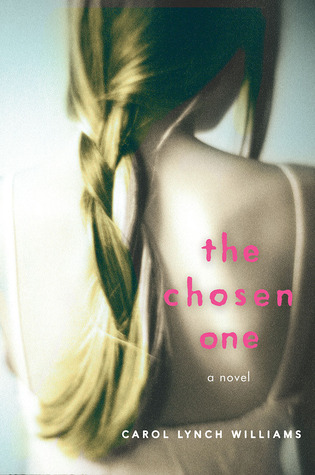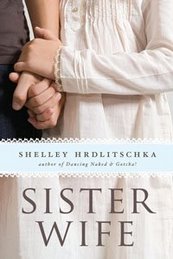
I talked about the suicide trend in teen lit earlier. Here’s another one that keeps popping up again and again, with definite mixed results: cults. More specifically, plural-marriage-accepting-religiously-fundamentalist cults. Here’s a quick over view of three of those titles, along with what works and what just doesn’t.
Last week, Michelle Dominguez Greene released her Keep Sweet with Simon Pulse. Keep Sweet follows Alva Jane as she falls in love with a boy within her Fundamentalist Latter Day Saints group in rural Uta (approximately an hour outside Moab, if that helps with setting up the story more). Of course, as readers we know this is going to be a problem because the boy was not decreed to be her husband by the Prophet.
Alva chooses to not “keep sweet” and escape her situation. Unfortunately, it takes over 100 pages to find Alva interesting in the least, and it seems as though her switch from being a believer in the Prophet and her religion is sudden and abrupt. Quite frankly, Alva chose to “keep sweet” for most of her life, and it takes little to change her. It’s the beating of another woman that makes her snap, but it wasn’t convincing to me as a reader. Here’s your spoiler warning, guys, so stop reading this paragraph if you don’t want this one ruined for you: within — I kid you not — five pages, she escapes, runs away to Moab, gets picked up by a couple going to California, stops in a gas station to see her sect was raided, makes the news, and then the folks who picked them up say (this is the icing): “Okay, I figure you are the girls they mentioned in the newscast.” The people who picked them up, along with everyone else in the sect, are utterly flat, voiceless, and nothing but air in the story. I mean, that’s some of the worst dialog I’ve read in a long time.
I found Keep Sweet a disappointment. It lacked on plot, and when the plot began to thicken, the writing and lack of development made it fall completely flat. The last chapter was utterly unrealistic, despite having a good premise. In my ideal world, this book would have about eight more chapters, with more development, more believability, and more character insight. It could have been a knock out. I think most readers will leave this one feeling cheated.
 I feel comfortable making those comments because last year, Carol Lynch Williams released what I think was the strongest book of this ilk: The Chosen One.
I feel comfortable making those comments because last year, Carol Lynch Williams released what I think was the strongest book of this ilk: The Chosen One.
It’s been over a year since I read this one, but I remember that the main character, Kyra, escapes to read at the bookmobile that often sits at the edge of the compound where she, too, lives with a polygamist-practicing family. She wants out, and it seems quite clear throughout the book this isn’t where she wants to be in her life.
This book was sparse, and it works. Williams develops a character — and she chooses not to overextend herself and develop more than a couple of characters — and a situation. In rereading my GoodReads notes, I mentioned that the characters aren’t especially well developed because of the sparse writing and that this was the important point in her story line. We know in this particular cult that who you are does not matter. It’s what you do. It is not a judgmental scenario in the same way that Greene’s is. Rather, we know Kyra’s not happy and wants to get out. Although Greene seeks to prove the same point about girls being simply there to provide children for the profit, her decision to dig into character development and fall flat while doing so (especially with characters like Brenda) weakens and buries that issue.
The Chosen One, I noted, was satisfying and fast-paced. This one seemed aimed at the younger end of teen readers, too. I think Greene’s may have aimed higher, especially with the end note about FLDS. It was published last May by St. Martins Griffin.
 Sister Wife by Shelley Hrdlitschka was the first book published with this theme (at least during the “trend” — I know others were published before this one) by Orca in October 2008.
Sister Wife by Shelley Hrdlitschka was the first book published with this theme (at least during the “trend” — I know others were published before this one) by Orca in October 2008.
Again, it’s been a year or more since I read this one, but thanks to GoodReads, I’m able to pull some memories together. To quote myself (oh I’ve always wanted to do that!), “My biggest problems were poor pacing (the end seems to skip years over pages), uninteresting characters, and unrealistic plot lines (the faith lines were so loose and sketchy, even in the polygamist setting, it was hard for me to really believe any of that backdrop). I think the stone setting and interaction among those within Unity and those outside was strange — in the polygamist stories we hear in the news, there is security and the places are compounds not easily broken into or out of. While certainly the story isn’t meant to be a strict telling of any of the real situations, I thought it had a lot of basis in reality and could have been better pushed in that direction. I just couldn’t get into this one because there were too many questions in my mind and none were really related to the characters themselves but on the writing/story choices.”
I did note that it deserved praise for the unique premise and situations that I hadn’t stumbled upon quite yet. And to be fair, knowing now this was an Orca publication, the pacing and the more shallow plot development makes sense. This publisher aims at the reluctant reader market, and I think this *is* a book that will appeal to them.
What struck me as most interesting in the trend of these books is they all have the same basic story line and characters — a girl, unhappy, tries to escape. We know that girls shoulder a lot of the weight in polygamist sects, but you know what I want? I’d eat up a book from the male’s perspective. What about a male who is fighting for power and control? What about a male trying to escape? There’s plenty of juice here, writers, and I’m eager to read it. It’s clear the trend’s big because of the news and the images we see in the news, but I’d like something with more twist to it.
That said, if you are looking for a good read, you have choices. I think of the three, The Chosen One holds the most promise, and perhaps that’s in part due to Williams’s experience in writing for the teen market.
